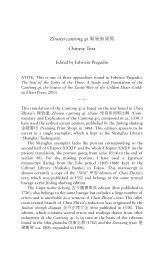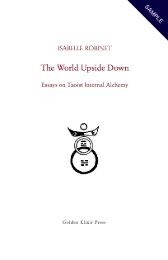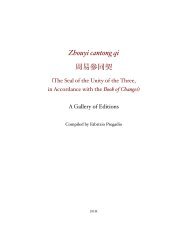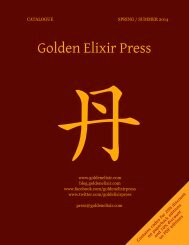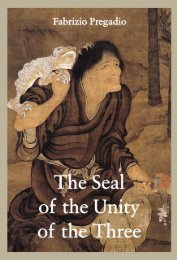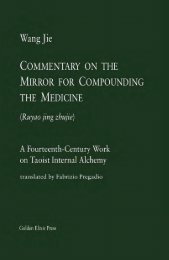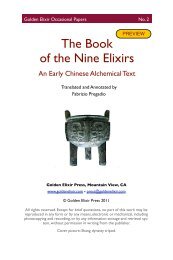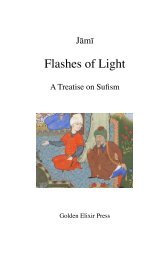The Seal of the Unity of the Three â Vol. 2 - The Golden Elixir
The Seal of the Unity of the Three â Vol. 2 - The Golden Elixir
The Seal of the Unity of the Three â Vol. 2 - The Golden Elixir
- No tags were found...
Create successful ePaper yourself
Turn your PDF publications into a flip-book with our unique Google optimized e-Paper software.
1. Tang Dynasty and Five Dynasties 119<br />
—————————————————————————————————————————<br />
無 、 皆 云 『 參 同 契 』 中 卷 是 也 、 深 屬 淺 見 矣 。<br />
Formerly, <strong>the</strong> True Man Wei Boyang transmitted to Chunyu Shutong<br />
<strong>the</strong> Cantong qi and <strong>the</strong> “Old Songs” by Xu Congshi, who came from<br />
Qingzhou (Shandong). When Wei Boyang compounded <strong>the</strong> <strong>Elixir</strong>, he<br />
wrote this Wu xianglei. Later he departed, mounting into <strong>the</strong> clouds, but<br />
ordered his disciples to inscribe [this book] in “seal characters” (dazhuan).<br />
None <strong>of</strong> <strong>the</strong> various editions [<strong>of</strong> <strong>the</strong> Cantong qi] includes [this book],<br />
and <strong>the</strong>y all state that [<strong>the</strong> original Wu xianglei] is <strong>the</strong> second chapter<br />
<strong>of</strong> <strong>the</strong> Cantong qi. This is indeed a very shallow view. 23<br />
<strong>The</strong> passage continues by saying that while <strong>the</strong> Wu xianglei that is<br />
found in <strong>the</strong> present-day Cantong qi deals with o<strong>the</strong>r matters, <strong>the</strong><br />
Biyao “is concerned with <strong>the</strong> different categories [<strong>of</strong> ingredients], and<br />
with <strong>the</strong> treatment <strong>of</strong> <strong>the</strong> <strong>Three</strong> Yellows (sanhuang 三 黃 , i.e., sulphur,<br />
realgar, and orpiment) and <strong>the</strong> Two Treasures (erbao 二 寶 , i.e., lead<br />
and mercury).”<br />
However, nei<strong>the</strong>r sulphur nor realgar and orpiment are part <strong>of</strong> <strong>the</strong><br />
discourse <strong>of</strong> <strong>the</strong> Cantong qi, which, as a matter <strong>of</strong> fact, blames those<br />
alchemist who “roast sulphur above camphor wood” (36:14), and <strong>the</strong>n<br />
enjoins: “Dispose <strong>of</strong> realgar!” (87:19). <strong>The</strong> same is true <strong>of</strong> <strong>the</strong> main<br />
part <strong>of</strong> <strong>the</strong> Biyao, which is devoted to establishing correspondences<br />
between twenty or so pairs <strong>of</strong> mineral and o<strong>the</strong>r ingredients, one <strong>of</strong><br />
which is Yin and <strong>the</strong> o<strong>the</strong>r is Yang: for example, cinnabar and mercury;<br />
realgar and orpiment; sulphur and magnetite; litharge and tin;<br />
brass and mercury; and salt and iron. 24 <strong>The</strong>se and several o<strong>the</strong>r<br />
23<br />
Cantong qi wu xianglei biyao, 1b. <strong>The</strong> study by Ho and Needham,<br />
“<strong>The</strong>ories <strong>of</strong> Categories in Early Mediaeval Chinese Alchemy”, p. 178,<br />
contains a different translation <strong>of</strong> this passage that does not deliver its main<br />
point. <strong>The</strong> passage is fully understandable only in <strong>the</strong> light <strong>of</strong> <strong>the</strong> controversies<br />
about <strong>the</strong> authorship <strong>of</strong> <strong>the</strong> Cantong qi (see <strong>The</strong> <strong>Seal</strong>, vol. 1, pp. 9–11).<br />
Before <strong>the</strong> entire Cantong qi was attributed to Wei Boyang, one <strong>of</strong> <strong>the</strong> views<br />
about its origins made Xu Congshi <strong>the</strong> author <strong>of</strong> <strong>the</strong> first chapter, and Wei<br />
Boyang <strong>the</strong> author <strong>of</strong> <strong>the</strong> second chapter, which consisted <strong>of</strong> explanations on<br />
<strong>the</strong> first one and was entitled Wu xianglei. See Zhouyi cantong qi (CT 999),<br />
preface, 1a. This work is approximately contemporary with <strong>the</strong> main text<br />
found in <strong>the</strong> Biyao.<br />
24<br />
See table II, p. 200, in Ho and Needham, “<strong>The</strong>ories <strong>of</strong> Categories”; and<br />
table 120 in Needham, Science and Civilisation in China, V.4:320.<br />
Visit <strong>the</strong> Web page on this book • www.goldenelixir.com



